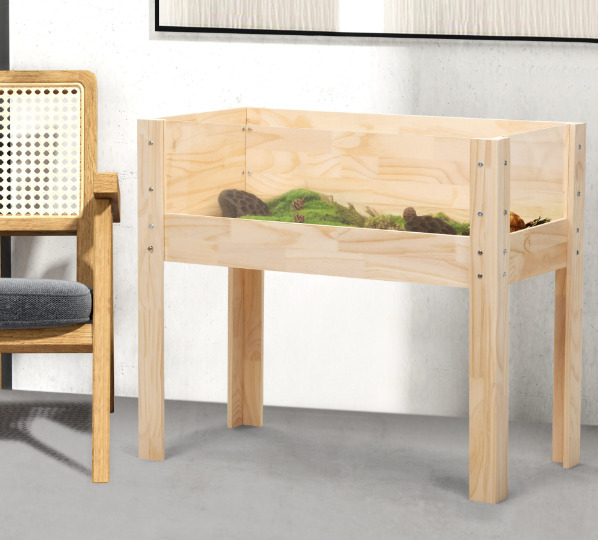Turtles are fascinating creatures that make wonderful pets, but ensuring their well-being requires careful consideration of their turtle habitat. From basking spots to proper substrate, here’s a comprehensive guide on what turtles need in their enclosure to thrive.
Turtle Habitat Essentials
Appropriate Size
One of the fundamental aspects of turtle care is providing an adequately sized turtle habitat. The size requirements vary based on the turtle species, so it’s crucial to research the specific needs of your turtle. Generally, a larger enclosure allows for more natural behaviors and promotes overall health. Ensure there is enough space for swimming, basking, and exploring.
Proper Substrate
Choosing the right substrate is essential for maintaining a clean and comfortable turtle habitat for your turtle. For aquatic turtles, a substrate like river rocks or smooth gravel is suitable. Substrate depth should accommodate digging behaviors. Terrestrial turtles may benefit from coconut coir, cypress mulch, or a combination of soil and sphagnum moss. A suitable substrate supports proper humidity levels and facilitates natural behaviors.
Safe and Secure Design
Ensure the turtle habitat is escape-proof and safe for your turtle. Use sturdy materials for the walls and secure any openings. If your turtle is an adept climber, consider the height of the enclosure walls to prevent escapes. Avoid using toxic plants or substrates, and regularly inspect the enclosure for any potential hazards.

Heating and Thermoregulation in Turtle Habitat
Basking and UVB Lighting
Turtles require access to both basking and UVB lighting to support their health. Basking areas in turtle habitat should include flat rocks or platforms positioned under a heat lamp. UVB lighting is crucial for the synthesis of vitamin D3, which is essential for calcium metabolism. Invest in high-quality UVB bulbs and ensure they are replaced regularly according to the manufacturer’s recommendations. Creating a gradient of temperature and UVB exposure allows turtles to regulate their body temperature effectively.
Adequate Heating and Thermoregulation
Maintaining the appropriate temperature gradient within the turtle habitat is vital. Turtles are ectothermic, meaning they rely on external heat sources to regulate their body temperature. Provide a heat lamp over the basking area to achieve a temperature range between 90-95°F (32-35°C). The ambient temperature in the rest of the enclosure should be slightly cooler, around 75-80°F (24-27°C). Monitoring temperatures with reliable thermometers ensures your turtle can thermoregulate effectively.
Habitat Variation and Zones
Introduce habitat of a turtle variation by creating distinct zones within the enclosure. For semi-aquatic turtles, include a transition zone with shallow water leading to the basking area. This variation in habitat zones provides turtles with options to explore different environments, promoting mental stimulation and natural behaviors.
Hydration and Water Quality in Turtle Habitat
Clean Water for Aquatic Turtles
If you have aquatic turtles, clean and properly filtered water in turtle habitat is paramount. Invest in a good water filtration system and conduct regular water changes to maintain water quality. The water level should be deep enough to allow swimming and diving but not so deep that the turtle struggles to reach the surface for breathing. Aquatic turtles also benefit from a dry, accessible basking area to prevent shell issues.
Consistent Hydration Opportunities
Ensure your turtle has consistent access to water for drinking and bathing. Hydration is crucial for their health and aids in proper digestion. Check water bowls or aquatic areas regularly in turtle habitat to ensure they are clean and replenish water as needed. Hydration is especially important for turtles that may not consume enough water through their diet alone.

Nutritional and Behavioral Enrichment
Balanced Diet
A well-rounded and species-specific diet in turtle habitat is vital for your turtle’s health. Research the dietary requirements of your turtle species and offer a variety of foods, including commercial turtle pellets, leafy greens, vegetables, and occasional protein sources like insects or small fish. Calcium and vitamin supplements may be necessary to ensure your turtle receives all essential nutrients.
Environmental Enrichment Toys
Provide environmental enrichment toys to keep your turtle mentally engaged. Floating objects, basking platforms with movable parts, and items they can push or interact with can stimulate their cognitive abilities. Rotate and introduce new toys in habitat of a turtle periodically to prevent boredom and encourage exploration.
Hiding Places and Enrichment
Provide hiding spots and enrichment opportunities to keep your turtle mentally stimulated. Rocks, logs, and plants can create hiding places and mimic a natural habitat. Additionally, introducing items like floating platforms or puzzle feeders in habitat of a turtle encourages exploration and foraging behavior. Enrichment is crucial for maintaining a turtle’s well-being and preventing boredom-related issues.
Monitoring and Seasonal Considerations
Monitoring and Recording Behaviors
Regularly monitor your turtle’s behaviors and habits. Keep a record of their eating patterns, basking durations, and any unusual behaviors. Monitoring helps you identify changes in behavior that could indicate health issues or adjustments needed in their habitat of a turtle. Understanding your turtle’s routine contributes to better overall care.
Seasonal Changes and Outdoor Enclosures
Consider seasonal changes, especially if you have an outdoor enclosure for your turtle. Outdoor time is beneficial for exposure to natural sunlight and environmental stimuli. Ensure outdoor habitat of a turtle has secure fencing to prevent escapes and protection from predators. Monitor temperature changes and bring indoor turtles inside if conditions become extreme.
Designing the perfect habitat of a turtle involves careful consideration of the species’ specific needs, from proper heating and lighting to a balanced diet and a secure habitat. By creating an environment that mimics their natural habitat and addressing their physical and mental needs, you can ensure your turtle leads a healthy and happy life. Regular observation, adjustments to their environment, and veterinary care contribute to a thriving turtle companion in a well-designed enclosure.
